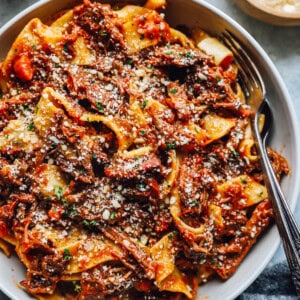Cozy, comforting, and packed with flavor, this Beef Ragu is so satisfying! Chuck roast cooked low and slow in a rich tomato and red wine sauce – pure joy! I’ve always loved beef ragu at a restaurant, but now making it at home is even better.

This post may include affiliate links that earn us a small commission from your purchases at no extra cost to you.
What’s in This Beef Ragu Recipe?
Beef Ragu is a classic Italian dish that’s loaded with goodies! Beef chuck roast is cooked slowly in a large pot, then smothered in a red wine sauce which has a wonderful depth of flavor. I serve with pasta for a super hearty meal, perfect for a filling weeknight or special occasion dinner!
- Beef: Chuck roast is perfect for the low and slow cooking we do in this recipe. It has great fat marbling that melts into the sauce to create a rich taste and texture. Other great cuts for ragu include beef brisket, beef shanks, or beef short ribs.
- Aromatics: Onion, celery, carrots, and garlic create a sweet and earthy base of flavor for this sauce that balances out the acidity of the tomatoes.
- Spices: Dried thyme, rosemary, and bay leaves add a fresh and herbal flavor.
- Red Wine: Adds acidity and deepens the flavor of the sauce. Use a full-bodied and slightly fruity wine like Merlot, Pinot Noir, Chianti, or a lighter Cabernet. Cooking wine will work in a pinch, but we recommend breaking out the good stuff for this sauce– enjoy a glass with dinner!
- Broth: Low-sodium beef broth adds a hit of umami flavor to the sauce that deepens the overall flavor. We highly recommend it over plain water. Beef bouillon is a handy tool to keep in the pantry for times like this!
- Crushed Tomatoes: Add rich tomato flavor, acidity, and texture to the sauce. We prefer to use canned tomatoes over fresh ones because the flavor is more concentrated.
- Pasta: Our favorite pasta for ragu is pappardelle, but any other ribbon pasta will hold up well to the sauce. For a truly impressive dish, learn how to make homemade pasta!
Variations on Braised Beef Ragu
There’s so much more to ragu than meets the eye. This low-and-slow cooking process lends itself well to many different meats. Try one of these other great dishes:
- Bolognese: Use ground beef, veal, lamb, pork, or a combination of any of those meats, and add nutmeg and milk. Use white wine in place of the red. Serve over tagliatelle or in a lasagna.
- Ragu di Prosciutto: Use prosciutto as the meat and add more extra-virgin olive oil. Omit the carrots and celery, and use white wine in place of the red. Serve over pappardelle or tagliatelle.
- Ragu d’agnello: Use ground lamb as the meat. Omit the carrots, celery, and onion. Serve over tagliatelle.
- Sugo di Carne: Use ground beef, pork, or a combination of both, optionally with porcini mushrooms. Serve with penne, rigatoni, farfalle, or fettuccini.
- Amatriciana: Use guanciale (cured pork jowl) and diced tomatoes. Omit the carrots, celery, and onions. Add hot peppers, if desired, and toss together with either spaghetti or bucatini pasta.

How to Store and Reheat
Beef ragu is a great make-ahead recipe because many argue it is best to let the ragu cool to room temperature, then store it overnight in the refrigerator. This overnight chill in the refrigerator helps the flavors to develop, creating a richer tasting ragu.
Store leftover beef ragu in an airtight container in the refrigerator for up to 3 days. Gently reheat on the stovetop or in the microwave until simmering.
How to Freeze
Freeze leftover beef ragu in an airtight container for up to 4 months. Let ragu thaw in the refrigerator overnight before reheating.

Serving Suggestions
This delicious pasta dish is a meal in its own right, but you can certainly add sides to make this a real feast. We like to start with a classic Olive Garden salad and add some easy cheesy garlic bread for sopping up any leftover sauce.
Notes from the Test Kitchen
The rich and delicious flavors in the beef ragu come out of a low and slow cook, giving this beloved pasta dish an incredible taste. The beef is super tender and the whole dish comes together in a large pot or Dutch oven. Your friends and family will go gaga for this lip-smacking ragu!
Beef Ragu Recipe

Equipment
- Dutch Oven
Ingredients
- 3 pounds beef chuck roast cut into large pieces
- Kosher salt and freshly ground black pepper to taste
- 3 tablespoons olive oil divided
- 1 onion chopped
- 2 ribs celery chopped
- 2 carrots chopped
- 4 cloves garlic minced
- ½ teaspoon dried thyme
- ½ teaspoon dried rosemary
- 2 bay leaves
- 1 cup red wine Merlot, Pinot Noir, Chianti, or lighter Cabernet
- 1 cup low-sodium beef broth
- 28 ounces crushed tomatoes (1 large can)
- 1 pound cooked pappardelle pasta for serving (1 box)
- Chopped fresh parsley optional, for garnish
- Freshly grated Parmesan cheese optional, for garnish
Instructions
- Season the beef generously with salt and pepper.3 pounds beef chuck roast, Kosher salt and freshly ground black pepper
- Heat 2 tablespoons of olive oil in a Dutch oven set over medium-high heat.3 tablespoons olive oil
- Sear the beef for a few minutes on each side to create a brown crust on the outside of each piece. Set aside on a plate.
- Pour the remaining 1 tablespoon of oil in the same pot.
- Add in the onion, celery, and carrots. Sprinkle with salt and cook until softened, about 5-6 minutes.1 onion, 2 ribs celery, 2 carrots
- Add in the garlic, thyme, rosemary, and bay leaves and cook for another minute.4 cloves garlic, ½ teaspoon dried thyme, ½ teaspoon dried rosemary, 2 bay leaves
- Pour in the red wine. Use a wooden spoon to scrape up the brown bits from the bottom of the pan.1 cup red wine
- Add in the beef broth, meat, and crushed tomatoes.1 cup low-sodium beef broth, 28 ounces crushed tomatoes
- Bring everything to a boil. Then, reduce to a simmer.
- Cover the pot, and cook for 2½-4 hours, until the beef can be easily shredded with a fork.
- Remove the bay leaves and beef from the pot.
- Shred the beef. Then, return it to the pot and stir it into the sauce and pan juices.
- Let the beef simmer for about 20 minutes to let the flavors deepen.
- Serve the beef ragu over cooked pappardelle pasta.1 pound cooked pappardelle pasta
- Finish with a sprinkle of chopped parsley and Parmesan cheese, if desired.Chopped fresh parsley, Freshly grated Parmesan cheese
Video
Becky’s Tips
- For the best-tasting ragu, prepare the recipe 1 day in advance and let the flavors develop in the refrigerator overnight.
- Nutritional information does not include optional ingredients.
Nutrition information is automatically calculated, so should only be used as an approximation.
How to Make Beef Ragu Step by Step
Sear the Beef: Season 3 pounds of beef chuck roast generously with salt and pepper. Heat 2 tablespoons of olive oil in a Dutch oven set over medium-high heat. Sear the beef for a few minutes on each side to create a brown crust on the outside of each piece. Set aside on a plate.

Cook the Aromatics: Pour the remaining 1 tablespoon of oil in the same pot. Add in 1 chopped onion, 2 chopped ribs of celery, and 2 chopped carrots. Sprinkle with salt and cook until softened, about 5-6 minutes.

Add the Spices: Add in 4 minced cloves of garlic, ½ teaspoon of dried thyme, ½ teaspoon of dried rosemary, and 2 bay leaves and cook for another minute.

Deglaze with Wine: Pour in 1 cup of red wine. Use a wooden spoon to scrape up the brown bits from the bottom of the pan.

Cook the Sauce: Add in 1 cup of low-sodium beef broth, the seared beef, and 28 ounces (1 large can) of crushed tomatoes. Bring everything to a boil. Then, reduce to a simmer. Cover the pot, and cook for 2½-4 hours, until the beef can be easily shredded with a fork.

Shred the Beef: Remove the bay leaves and beef from the pot. Shred the beef. Then, return it to the pot and stir it into the sauce and pan juices.

Simmer the Sauce: Let the beef simmer for about 20 minutes to let the flavors deepen.

Garnish and Serve: Serve the beef ragu over 1 pound of cooked pappardelle pasta. Finish with a sprinkle of chopped parsley and Parmesan cheese, if desired.

Ragu is an Italian meat-based sauce served with pasta. It typically consists of veal, lamb, beef, or pork mixed with sofrito (carrots, celery, and onions) and tomato. It is cooked low and slow to produce a tender, savory sauce.
Bolognese sauce is actually a variation of ragu. In Italy, it’s called ragu alla bolognese. Traditionally, bolognese is made with a combination of beef and pork cooked with white wine and served over tagliatelle pasta. It usually also includes milk and nutmeg.
A fatty cut of beef with great marbling works best for this dish. The low and slow cooking process lends itself well to typically tough cuts, like chuck roast, brisket, beef shanks, or beef short ribs.

















Just made this and it was SOOO good! I didn’t have red wine so I used red wine vinegar. I know it sounds weird but Google said it was a good swap and I can confirm! The flavor was on point :)
I have this in the oven right now – I have looked and looked and see no mention of a cook temperature. I have it at 300 but could be really hard for inexperienced cooks. Also it doesn’t mention taking the beef out of the pot after searing before sautéing the veggies and adding the wine and then putting it back in before putting in the oven. I did this because I have made many similar recipes and also I would not be able to sear all the beef properly at once.
Hi Pam, this is a stovetop recipe, so we do not give exact temperatures as our stove only has settings 1-6, not temperatures like the oven. Every stove is different, so we call out “medium-high” to give an idea of the temperature range– your knob should be set right in the middle of medium and high heat. For me, I usually place my stove on 4 or 5, but that may be different for you! In step 3 we also call out setting the beef aside after searing. Hope that helps a bit!
Made this with some creamy cheesy polenta…. OH MY WORD!!! It was soooo very good! Friends and family loved it! Thank you for this gorgeous recipe!